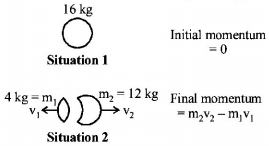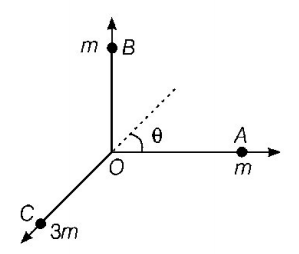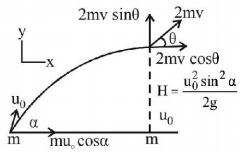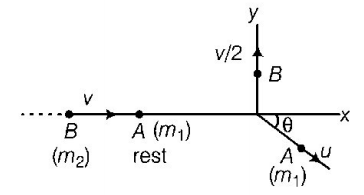1. A $$600\,kg$$ rocket is set for a vertical firing. If the exhaust speed is $$1000\,m{s^{ - 1}},$$ the mass of the gas ejected per second to supply the thrust needed to overcome the weight of rocket is
A.
$$117.6\,kg\,{s^{ - 1}}$$
B.
$$58.6\,kg\,{s^{ - 1}}$$
C.
$$6\,kg\,{s^{ - 1}}$$
D.
$$76.4\,kg\,{s^{ - 1}}$$
Answer :
$$6\,kg\,{s^{ - 1}}$$
2. In a collinear collision, a particle with an initial speed $${v_0}$$ strikes a stationary particle of the same mass. If the final total kinetic energy is 50% greater than the original kinetic energy, the magnitude of the relative velocity between the two particles, after collision, is:
A.
$$\frac{{{v_0}}}{4}$$
B.
$$\sqrt 2 {v_0}$$
C.
$$\frac{{{v_0}}}{2}$$
D.
$$\frac{{{v_0}}}{{\sqrt 2 }}$$
Answer :
$$\sqrt 2 {v_0}$$
3. A machine gun fires a bullet of mass $$40g$$ with a velocity $$1200m{s^{ - 1}}.$$ The man holding it can exert a maximum force of $$144N$$ on the gun. How many bullets can he fire per second at the most?
A.
Two
B.
Four
C.
One
D.
Three
Answer :
Three
4. A bomb of mass $$16kg$$ at rest explodes into two pieces of masses $$4kg$$ and $$12kg.$$ The velolcity of the $$12kg$$ mass is $$4\,ms^{ - 1}.$$ The kinetic energy of the other mass is
A.
$$144J$$
B.
$$288 J$$
C.
$$192 J$$
D.
$$96 J$$
Answer :
$$288 J$$
5. $$1\,kg$$ body explodes into three fragments. The ratio of their masses is $$1:1:3.$$ The fragments of same mass move perpendicular to each other with speeds $$30\,m/s,$$ while the heavier part remains in the initial direction. The speed of heavier part is
A.
$$\frac{{10}}{{\sqrt 2 }}m/s$$
B.
$$10\sqrt 2 \,m/s$$
C.
$$20\sqrt 2 \,m/s$$
D.
$$30\sqrt 2 \,m/s$$
Answer :
$$10\sqrt 2 \,m/s$$
6. A particle of mass $$m$$ is projected from the ground with an initial speed $${u_0}$$ at an angle $$\alpha $$ with the horizontal. At the highest point of its trajectory, it makes a completely inelastic collision with another identical particle, which was thrown vertically upward from the ground with the same initial speed $${u_0}.$$ The angle that the composite system makes with the horizontal immediately after the collision is
A.
$$\frac{\pi }{4}$$
B.
$$\frac{\pi }{4} + \alpha $$
C.
$$\frac{\pi }{2} - \alpha $$
D.
$$\frac{\pi }{2}$$
Answer :
$$\frac{\pi }{4}$$
7. A body of mass $$2 kg$$ makes an elastic collision with a second body at rest and continues to move in the original direction but with one fourth of its original speed. What is the mass of the second body?
A.
$$1.0 kg$$
B.
$$1.5 kg$$
C.
$$1.8 kg$$
D.
$$1.2 kg$$
Answer :
$$1.2 kg$$
8.
There block $$A, B$$ and $$C$$ are lying on a smooth horizontal surface, as shown in the figure. $$A$$ and $$B$$ have equal masses, $$m$$ while $$C$$ has mass $$M.$$ Block $$A$$ is given an initial speed $$v$$ towards $$B$$ due to which it collides with $$B$$ perfectly inelastically. The combined mass collides with $$C,$$ also perfectly inelastically $$\frac{5}{6}th$$ of the initial kinetic energy is lost in whole process. What is value of $$M/m$$ ?

A.
5
B.
2
C.
4
D.
3
Answer :
4
9. A particle moves in the $$X$$ - $$Y$$ plane under the influence of a force such that its linear momentum is $$\vec p\left( t \right) = A\left[ {\hat i\cos \left( {kt} \right) - \hat j\sin \left( {kt} \right)} \right],$$ where $$A$$ and $$k$$ are constants, The angle between the force and the momentum is
A.
$${0^ \circ }$$
B.
$${30^ \circ }$$
C.
$${45^ \circ }$$
D.
$${90^ \circ }$$
Answer :
$${90^ \circ }$$
10. Two spheres $$A$$ and $$B$$ of masses $${m_1}$$ and $${m_2}$$ respectively collide. $$A$$ is at rest initially and $$B$$ is moving with velocity $$v$$ along $$x$$-axis. After collision, $$B$$ has a velocity $$\frac{v}{2}$$ in a direction perpendicular to the original direction. The mass $$A$$ moves after collision in the direction
A.
same as that of $$B$$
B.
opposite to that of $$B$$
C.
$$\theta = {\tan ^{ - 1}}\left( {\frac{1}{2}} \right)$$ to the $$x$$-axis
D.
$$\theta = {\tan ^{ - 1}}\left( {\frac{{ - 1}}{2}} \right)$$ to the $$x$$-axis
Answer :
$$\theta = {\tan ^{ - 1}}\left( {\frac{1}{2}} \right)$$ to the $$x$$-axis




